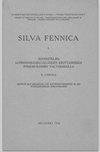Effect of pruning season and tool on knot occlusion and stem discolouration in Betula pendula – situation five years after pruning
IF 1.7
3区 农林科学
Q2 FORESTRY
引用次数: 4
Abstract
This paper investigates and models the effects of pruning season and tool on wound occlusion with varying tree and branch characteristics of silver birch (Betula pendula Roth) stems at the pruning height of 0â4 metres. Dates of eight secateurs prunings, three saw prunings and two sticks prunings as well as unpruned control were tested in permanent plots on four sites. Knot occlusion and discolouration in stemwood were measured from about 1600 studied knots of 112 sample trees felled five to six years after pruning in 2010. Knot occlusion rate was modelled according to pruning tool, date, tree growth, and branch characteristics. The occlusion was the fastest in trees pruned in spring or early summer, and the slowest in trees pruned in autumn. Stubs of living branches occluded faster than the dead ones with the same diameter. Saw pruning resulted in clearly better occlusion rates than secateurs pruning, caused by the shorter knot stubs after saw pruning. Hitting dead branches away with a stick resulted in the worst occlusion status. The colour defects spread more often upward from the knot than downward. Discolouration in stemwood was detected more frequently near to the pruned branches than the unpruned ones, and more widely near to the stubs of dead branches than the living ones. Most saw and secateurs pruned branches were completely occluded during the experiment, so these prunings were suitable for all branches under 20 mm in diameter, and for living branches even up to 30 mm in fast-growing trees.修剪季节和修剪工具对钟桦结和茎变色的影响——修剪后5年的情况
本文研究并模拟了在修剪高度为0 ; 4米的白桦树(Betula pendula Roth)的树干和树枝特征不同的情况下,修剪季节和工具对伤口闭合的影响。在4个试验点的永久样地进行了8个剪枝、3个锯枝和2个棍枝修剪和未修剪对照的树龄试验。研究人员对112棵样本树的1600个结进行了测量,这些树在2010年修剪了5到6年后被砍伐。根据修剪工具、日期、树木生长和树枝特征建立结闭塞率模型。在春季和初夏修剪的树木中,封闭最快,而在秋季修剪的树木中,封闭最慢。同样直径的活枝比死枝闭塞得快。由于锯剪后的结桩较短,锯剪后的密闭率明显优于剪剪。用棍子把枯枝敲掉导致了最糟糕的闭塞状态。颜色缺陷往往从结向上而不是向下扩散。茎材变色在修剪过的枝条附近比未修剪过的枝条附近更常见,在枯枝的残根附近比在活枝的残根附近更普遍。在试验过程中,锯剪和剪剪后的树枝大部分被完全封闭,因此这些修剪方法适用于所有直径小于20 mm的树枝,甚至适用于速生树木的活枝,甚至30 mm。
本文章由计算机程序翻译,如有差异,请以英文原文为准。
求助全文
约1分钟内获得全文
求助全文
来源期刊

Silva Fennica
农林科学-林学
CiteScore
3.50
自引率
11.10%
发文量
21
审稿时长
3 months
期刊介绍:
Silva Fennica publishes significant new knowledge on forest sciences. The scope covers research on forestry and forest ecosystems. Silva Fennica aims to increase understanding on forest ecosystems, and sustainable use and conservation of forest resources. Use of forest resources includes all aspects of forestry containing biomass-based and non-timber products, economic and social factors etc.
 求助内容:
求助内容: 应助结果提醒方式:
应助结果提醒方式:


